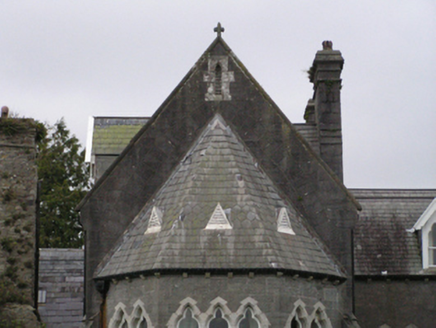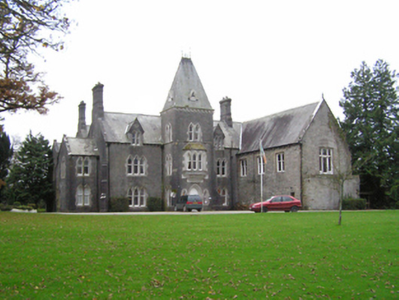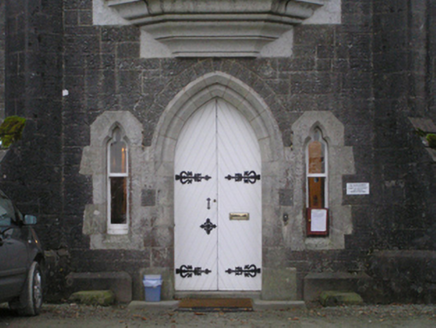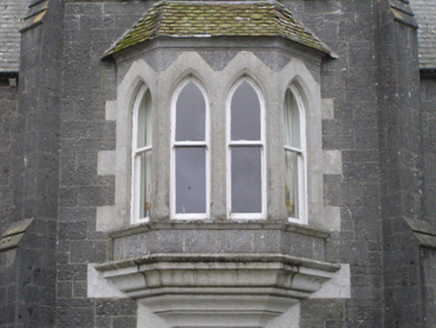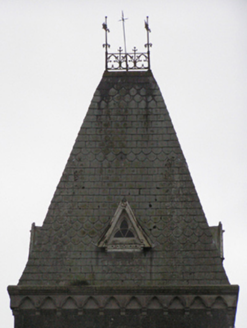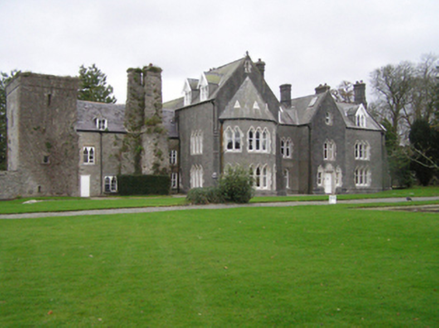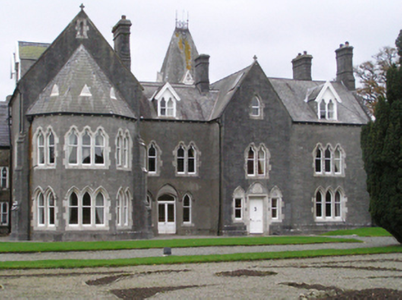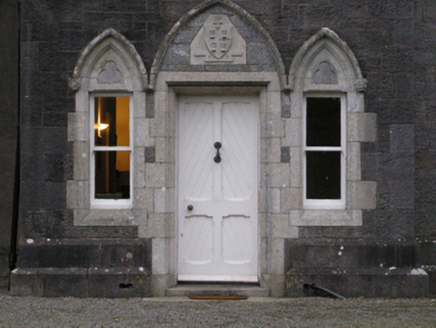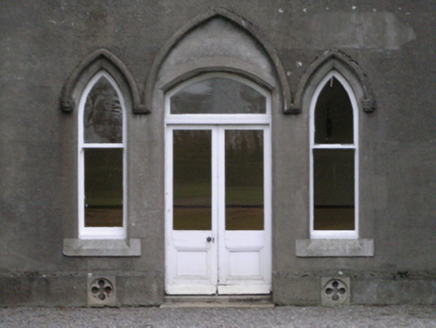Survey Data
Reg No
12321004
Rating
National
Categories of Special Interest
Archaeological, Architectural, Artistic, Historical, Social
Previous Name
Knocktopher House
Original Use
Country house
In Use As
Country house
Date
1865 - 1870
Coordinates
253268, 137074
Date Recorded
15/06/2004
Date Updated
--/--/--
Description
Detached three-bay two-storey double-pile country house with dormer attic, built 1866, on a T-shaped plan centred on single-bay three-stage tower on a square plan; three-bay two-storey rear (south) elevation centred on single-bay two-storey gabled breakfront. Occupied, 1901; 1911. Sold, 1981. Pitched double-pile (M-profile) slate roof including gablets to window openings to dormer attic, clay ridge tiles, lichen-spotted cut-limestone coping to gables on cut-limestone "Cavetto" kneelers with margined limestone ashlar buttressed chimney stacks to apexes having stringcourses below capping supporting terracotta or yellow terracotta pots, and cast-iron rainwater goods on cut-granite consoles retaining cast-iron octagonal or ogee hoppers and downpipes. Tuck pointed snecked limestone walls on dragged cut-limestone chamfered stepped plinth with margined limestone ashlar diagonal stepped buttresses to corners having moss-covered "slated" coping. Pointed-arch central door opening between cusped lancet window openings with cut-granite step threshold, and cut-granite block-and-start surround having chamfered rebated reveals framing diagonal timber boarded double doors. Lancet window openings in bipartite arrangement ("cheeks"), cut-granite block-and-start surrounds having chamfered reveals with hood mouldings on foliate label stops framing one-over-one timber sash windows. Lancet window openings (second stage) with cut-granite block-and-start surround having chamfered reveals framing one-over-one timber sash windows. Paired cusped lancet window openings (top stage) with cut-granite sill course, and cut-granite block-and-start surrounds having chamfered reveals framing one-over-one timber sash windows. Lancet window openings in tripartite arrangement (ground floor), cut-granite block-and-start surrounds having chamfered reveals with hood mouldings on foliate label stops framing one-over-one timber sash windows. Cusped lancet window openings in tripartite arrangement (first floor) with cut-granite block-and-start surrounds having chamfered reveals framing one-over-one timber sash windows. Paired lancet window openings (dormer attic) with cut-granite surrounds having chamfered reveals framing one-over-one timber sash windows. Square-headed central door opening (south) between square-headed window openings with cut-granite step threshold, and cut-granite block-and-start surround having chamfered reveals with hood moulding on foliate label stops framing diagonal timber boarded door. Cusped lancet window openings in bipartite arrangement (first floor) with cut-granite block-and-start surrounds having chamfered reveals framing one-over-one timber sash windows. Lancet window openings in tripartite arrangement (ground floor), cut-granite block-and-start surrounds having chamfered reveals with hood mouldings on foliate label stops framing one-over-one timber sash windows. Cusped lancet window openings in tripartite arrangement (first floor) with cut-granite surrounds having chamfered reveals framing one-over-one timber sash windows. Interior including (ground floor): vestibule; square-headed door opening into hall with glazed timber panelled double doors having sidelights on panelled risers below overlight; hall retaining carved timber surrounds to door openings framing timber panelled doors, moulded plasterwork cornice to ceiling, timber panelled staircase on a dog leg plan with Solomonic balusters supporting carved timber banister terminating in timber newels, carved timber surround to window opening to half-landing, carved timber surrounds to door openings to landing framing timber panelled doors, and moulded plasterwork cornice to ceiling; and carved timber surrounds to door openings to remainder framing timber panelled doors with carved timber surrounds to window openings. Set in landscaped grounds.
Appraisal
A country house erected for Lieutenant-Colonel Sir James Langrishe JP DL (1832-1910) to designs by John McCurdy (c.1824-85) of Leinster Street, Dublin (Dublin Builder 15th August 1866, 209), representing an important component of the mid nineteenth-century domestic built heritage of County Kilkenny with the architectural value of the composition, one abutting the remains of 'a monastery for Carmelite friars founded [1356] by James [Butler (1331-82)] the second Earl of Ormonde' [SMR KK031-017008-], confirmed by such attributes as the asymmetrical footprint centred on a "Châteauesque" tower; the construction in a deep grey limestone offset by glimmering granite dressings not only demonstrating good quality workmanship, but also producing a sober two-tone palette; the slender profile of the coupled and tripled openings with the principal "apartments" defined by a polygonal bay window; and the miniature gablets embellishing the roofline. Having been well maintained, the elementary form and massing survive intact together with substantial quantities of the original fabric, both to the exterior and to the interior where contemporary joinery; restrained chimneypieces; and sleek plasterwork refinements, all highlight the artistic potential of the composition. Furthermore, adjacent outbuildings (see 12321005); and a walled garden (----), all continue to contribute positively to the group and setting values of an estate having historic connections with the Langrishe family including Captain Sir Hercules Robert Langrishe JP DL (1859-1943), fifth Baronet (NA 1901; NA 1911); Captain Sir Terence Hume Langrishe (1895-1973), sixth Baronet; and Lieutenant Sir Hercules Ralph Hume Langrishe (1927-98), seventh Baronet. NOTE: Surviving drawings for an unexecuted wing are signed (20th March 1890) by Richard Langrishe JP (1834-1922), one-time Architect to the Church of Ireland Dioceses of Ossory, Ferns and Leighlin (fl. 1872-80).
